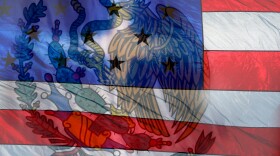NUEVO LAREDO, Tamaulipas, Mexico — Abraham Hernández sweeps dirt and litter from the curb outside his house in the La Nueva Era neighborhood of Nuevo Laredo.
Two decades ago, when he first settled here, he wouldn’t even stand on this spot.
“Are you kidding me? No way. It was ugly out there, ugly I tell you,” he said as he suddenly stopped sweeping to make his point, and then picked it right back up.
“I was out here at all kind of hours just to try to keep stuff from getting inside the house,” Hernández lamented. The former dirt roads would kick up nasty dust during dry weather and turn into mud pits when it rained.
Either way, it made living here miserable. One wouldn’t think asphalt would drastically change the quality of life here, yet Hernández and other neighbors said that’s precisely what happened.
”It just gave us a better sense of place. We felt a bit more proud to live here and say we’re from here,” said Blanca Velázquez, owner of a Mini Super Los Cuates, a mini-mart her family has operated here for 19 years.
The improvement project, which paved 55 street miles two years ago, was conducted by Nuevo Laredo’s public works department — but the city didn’t pay for it.
Funding came from the North American Development Bank, or NADBANK, which is jointly funded by the U.S. and Mexican governments.
It was created through the North American Free Trade Agreement, commonly known as NAFTA, which was signed by the U.S., Mexico and Canada 20 years ago.
“The Bank was created with a purpose of helping both governments to have a tool to protect, preserve and enhance the environment and the quality of life of border communities,” said Gerónimo Gutiérrez, director of NADBANK and member of former Mexican President Vicente Fox’s cabinet.
Since its inception in 1994, the bank has invested $1.2 billion in 155 projects on both sides of the border, Gutiérrez said. Most target basic services, from street paving to sewer systems. And thanks to new sewage plants, now 85 percent of raw water is treated, compared to 27 percent pre-NAFTA. Numbers are one thing, but many residents scattered in various neighborhoods across this city of nearly 400,000 people said they have seen and felt the impact.
Three elderly men sit on a rickety bench listening to the radio in a neighborhood named “150th Anniversary,” after the city’s birthday.
One of them, Adonis Mercado, was one of the first to buy a chunk of what was then a dirt lot 12 years ago. He had no basic services.
He slowly gets up and, with this cane, points to the spot.
“I had to use a car battery to get some electricity and had to buy water from a truck that came by every three days,” Mercado explained.
But that was non-potable water — just for bathing and cleaning. NADBANK funding brought in drinking water and other services years later.
Over the last four months, it has organized a series of workshops for water treatment operators in eight Mexican border cities.
At a training workshop in a Nuevo Laredo plant this month, the bank brought in expert Roberto Parra from Monterrey Institute of Technology to lead the course.
Workers currently do the best they can, but many of them follow outdated techniques and need better knowledge of chemical contents to conduct more accurate tests, Parra said.
“They deal daily with the problem but they need this knowledge to build up their confidence to manage better the process,” he said. Plant manager Juan Pérez agreed, saying he simply has no professional development budget.
He hoped NADBANK can provide more training down the line.
The bank seems to have been good to Nuevo Laredo. The city has been the second-leading recipient of funding, after Tijuana — surprising to some who would have thought Ciudad Juárez would have been up there.
The bank funded projects in 2010 and 2011 worth $111 million and two new ones this year provide an additional $40 million infusion.
The treaty was signed in San Antonio, where NADBANK is still headquartered.
Solís said bank projects are more about helping businesses thrive than helping the poor survive.
“What a change in 20 years — not much, it’s gotten worse,” he said. “That whole plan of modernizing the border, which is what we had intended, has not materialized at all.”
But for many people in Mexican border cities with NADBANK projects like Nuevo Laredo, it seems clear that if life is still hard, at least it’s not as hard as it used to be.







